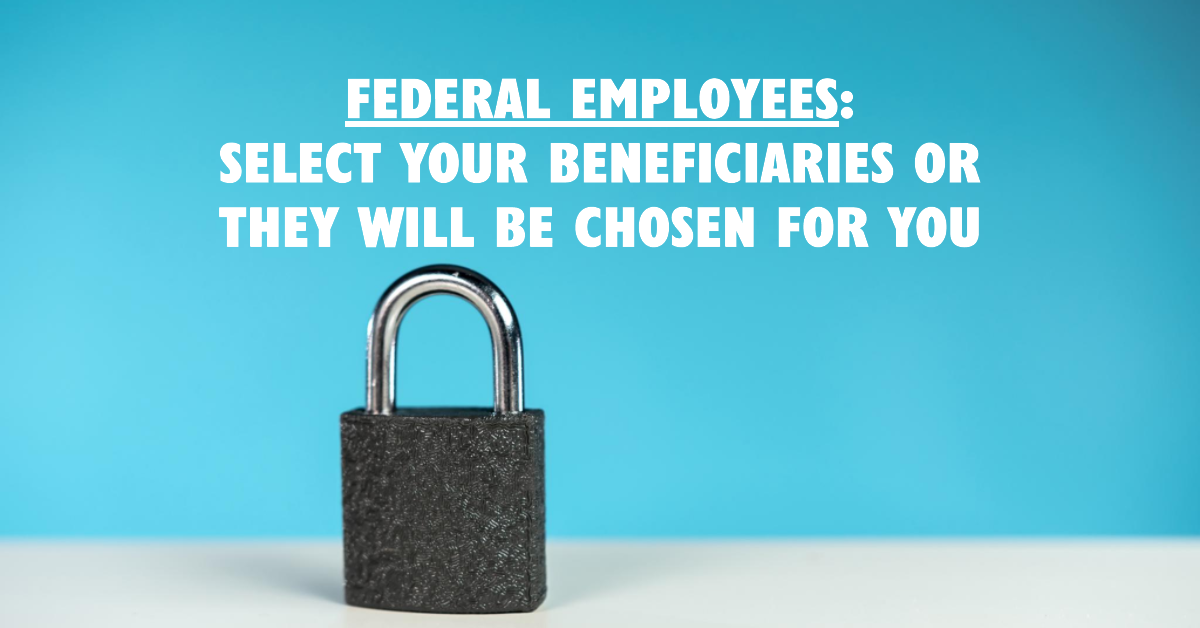Federal Employees: Select Your Beneficiaries OR They Will Be Chosen For You
We often see beneficiaries are left unchanged since joining Federal service. Big life events such as marriage, divorce, children, or the death of a previously designated beneficiary could have happened during this time. Life changing events require a review of your beneficiaries on file so that your benefits are left to the person you wish. If not updated, benefits such as TSP, FEGLI, and retirement survivor benefits could be received by a person you did not intend.
If you do not have a beneficiary, it will be chosen for you by the default based on the “Statutory Order of Precedence.”
It is crucial to review each beneficiary with its respective benefit. Below we will review each benefit and the process or form required to update your beneficiary.
Important: check your designated beneficiaries’ addresses. If not current, your beneficiary may not be located and prevent the payment of benefits.
Statutory Order of Precedence
The statutory order of precedence will take place if you do not have a beneficiary on file. It is best practice to not rely on the order of precedence and elect the beneficiaries yourself.
- To your widow or widower.
- If none, to your child or children equally, and descendants of deceased children by representation.
- If none, to your parents equally or to the surviving parent.
- If none, to the appointed executor or administrator of your estate.
- If none, to your next of kin who is entitled to your estate under the laws of the state in which you resided at the time of your death.
In this order of precedence, a child includes a natural child and an adopted child, but does not include a stepchild whom you have not adopted; parent does not include a stepparent, unless your stepparent has adopted you. By representation means that if one of your children dies before you do, that childs share will be divided equally among his or her children.
Thrift Savings Plan (TSP)
To add or update beneficiary information, log in to “My Account” at www.tsp.gov
Adding and updating one or more beneficiaries to your account is easy to do and only takes a few minutes online. Before you get started, make sure to have the Social Security number, full name, date of birth, and address of each beneficiary. If you beneficiary is a trust, estate, or organization, you will need to know the trustee’s, executor’s, or business’s information.
Federal Employee Group Life Insurance (FEGLI)
To update FEGLI beneficiaries you will need to use form SF-2823: https://www.opm.gov/forms/pdf_fill/sf2823.pdf
FEGLI benefits would include the options if any that you have chosen. These include:
- Basic
- Option A
- Option B
- Option C (on a spouse or child)
More information on FEGLI can be found below:
FEGLI ABC – Federal Employee Group Life Insurance Options in Retirement
FEGLI vs Private Insurance – Which Should You Choose?
Federal Employee Group Life Insurance (FEGLI)
Retirement Survivor Benefits
To update FERS designation of beneficiary use form SF-3102: https://www.opm.gov/forms/pdf_fill/sf3102.pdf
Basic Employee Death Benefit (BEDB)
The BEDB is a lump sum death benefit payment made to the surviving spouse of a married FERS employee who dies while in federal service. The spouse may be eligible for the BEDB, which is equal to 50% of the employee‘s final salary or average salary if higher, plus a lump sum of $40,300 (effective 2022), adjusted for inflation annually.
Requirements:
If an employee dies with at least 18 months of creditable civilian service under FERS, a survivor annuity may be payable if:
- the surviving spouse was married to the deceased for at least nine months, or
- the employee’s death was accidental, or
- there was a child born of the marriage to the employee.
Lump Sum Benefit
If an employee dies and no survivor annuity is payable based on his/her death, the retirement contributions remaining to the deceased person’s credit in the Civil Service Retirement and Disability Fund, plus applicable interest, are payable.
FERS Monthly Survivor Annuity
There is no paperwork required for the FERS survivor annuity. We detail below the different types of survivor benefits available.
Death of a Former Federal Employee Under FERS
Surviving Spouse
If a former employee who dies with at least 10 years of creditable service (5 years of which must be creditable civilian service) is survived by a spouse who was married to the deceased at the time of his/her separation from Federal civilian service AND who:
- was married to the deceased for at least nine months, or
- the former employee’s death was accidental, or
- there was a child born of the marriage to the former employee;
The spouse may be eligible for a monthly survivor benefit. The benefit begins on the date the deceased former employee would have been eligible for an unreduced annuity, unless the survivor chooses to have it begin at a lower rate on the day after the employee’s death.
Instead of a survivor annuity, the eligible spouse can elect to receive a lump sum payment of the contributions remaining to the deceased person’s credit in the retirement fund.
Death of Employee Covered Under the FERS
To the Current Spouse if
- the employee who died completed at least 10 years of creditable service (18 months of which must be creditable civilian service),
- the employee who died was covered by the Federal Employees Retirement System (FERS) when he/she died, and
- the current spouse was married to the employee for at least nine months (if the death was accidental or there was a child born of the marriage to the employee, the nine month requirement does not apply).
If a court order awards part of the total survivor annuity to a former spouse, the current spouse will receive the remainder. If the former spouse loses entitlement because of death or remarriage before age 55, the current spouse may begin to receive the full annuity.
To a Former Spouse if
- specified under a qualifying court order,
- the employee who died completed at least 18 months of creditable civilian service,
- the former spouse was married to the employee for at least nine months, and
- the former spouse did not remarry before reaching age 55 (unless he/she was married to the deceased for at least 30 years).
To a Child if
- the employee completed at least 18 months of creditable civilian service, and
- the child is an
- unmarried dependent child under age 18, and/or
- unmarried dependent child from age 18 to age 22, if attending an accredited educational institution full-time, and/or
- unmarried, disabled dependent child if the disability (certified as such by the Social Security Administration) occurred before age 18.
The combined benefit of all the children is reduced by the total amount of child’s insurance benefits that are payable (or would, upon proper application, be payable) under Title II of the Social Security Act for the same month to all children of the deceased based on the total earnings of the deceased. In many cases, the FERS children’s benefit is reduced to $0.
Unpaid Compensation
Not related to beneficiaries but relevant to the topic. If you need to receive any unpaid compensation you will use form SF-1152.
https://www.opm.gov/forms/pdf_fill/sf1152.pdf
How to Apply for Benefits in the Event of a Death
Contact the personnel office of the Federal agency where the employee worked. Complete the Application for Death Benefits, form SF-3104 and attach any other forms and/or evidence as the application or circumstances require. Attach a copy of the employee’s death certificate and a copy of the certificate of the marriage to the widow or widower. Give the application to the personnel office. If you are the surviving spouse or former spouse, you and deceased person’s employing agency should also complete SF-3104 Standard Documentation and Elections in Support of Application for Death Benefits when Deceased was an Employee at the Time of Death.
A widow or widower who is claiming benefits for himself/herself and on behalf of children should file one application.
Form SF-3104: https://www.opm.gov/forms/pdf_fill/sf3104.pdf
Reach Out to Us!
If you have additional federal benefit questions, reach out to our team of CERTIFIED FINANCIAL PLANNER™ (CFP®) and Chartered Federal Employee Benefits Consultants (ChFEBC℠). At PlanWell, we focus on retirement planning for federal employees. Learn more about our process designed for the career federal employee.
Preparing for a federal retirement? Check out our scheduled federal retirement workshops. Sign up for our no-cost federal retirement webinars here! Make sure to plan ahead and reserve your seat for our FERS webinar, held every three weeks. Interested in having PlanWell host a federal retirement seminar for your agency? Reach out, and we can collaborate with HR to arrange an on-site FERS seminar.
Want to fast-track your federal retirement plan? Skip the FERS webinar and start a one-on-one conversation with a ChFEBC today. You can schedule a one-on-one meeting here.








